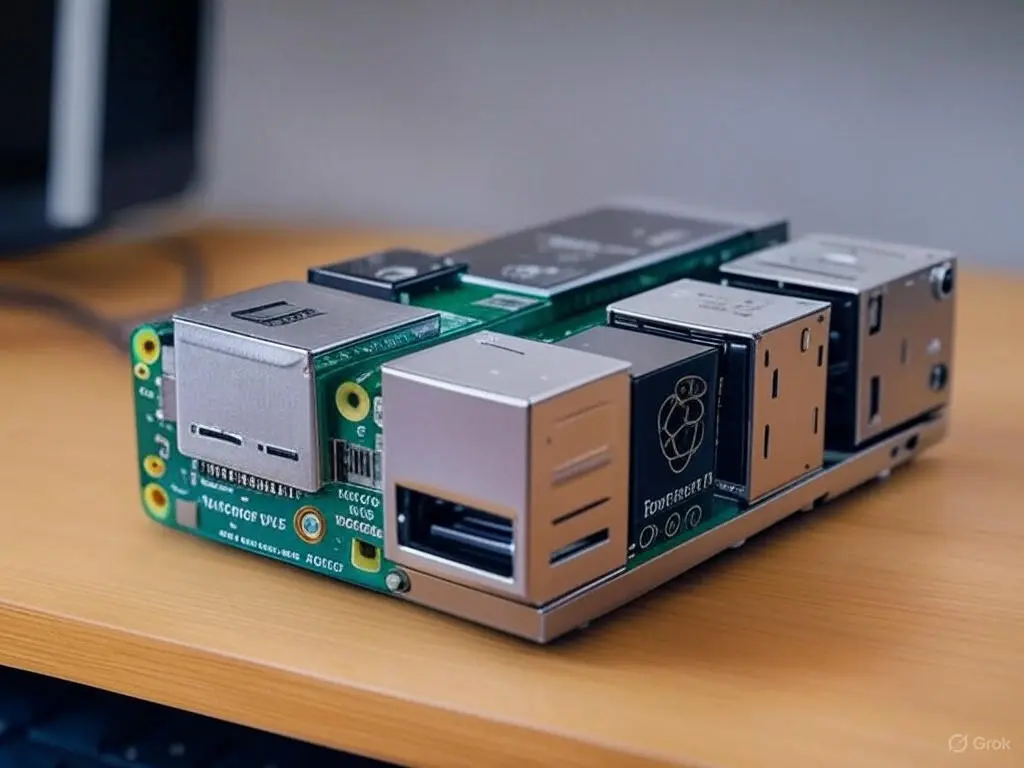In 2025, the Raspberry Pi remains a favourite for tech enthusiasts building affordable, powerful home servers.
Whether you want to stream movies with Plex, store files with Nextcloud, or automate your smart home with Home Assistant, the Raspberry Pi—especially the cutting-edge Raspberry Pi 5—offers unmatched versatility.
This guide walks you through everything you need to create your own Raspberry Pi home server, from choosing hardware to configuring services. Ready to take control of your digital world? Let’s dive in!
Why Choose Raspberry Pi for a Home Server?

The Raspberry Pi combines affordability, compact size, and low power consumption, making it perfect for 24/7 home server tasks.
The Raspberry Pi 5, released with a 2.4GHz quad-core Cortex-A76 processor and up to 8GB RAM, delivers up to 2- 3x the performance of the Pi 4.
It handles demanding applications like media streaming or multi-container Docker setups with ease. Its energy-efficient design keeps electricity costs low, and its vibrant community ensures plenty of tutorials and support.
Imagine hosting your own Netflix-like media server or blocking ads across your network—all for under $100. That’s the power of a Raspberry Pi home server in 2025.
Hardware Requirements
To build a reliable Raspberry Pi home server, select hardware that balances performance and durability:
- Raspberry Pi Model: Choose the Raspberry Pi 5 (4GB or 8GB RAM) for superior speed and multitasking, or the Raspberry Pi 4 (4GB RAM) for budget-conscious setups. The Pi 5’s upgraded CPU and GPU make it ideal for intensive tasks like running a NAS or home automation hub.
- Storage: Opt for a USB 3.0 SSD (e.g., Samsung T7, 500GB) for faster read/write speeds and better durability than SD cards. For Pi 5 users, consider an NVMe SSD with a compatible hat (e.g., Pineberry Pi) for blazing-fast storage. SSDs are pricier but reduce wear-related failures.
- Power Supply: Use a 5V/3A USB-C power supply for the Pi 5 or 5V/2.5A for the Pi 4. Ensure stability with a high-quality adapter to avoid undervoltage issues.
- Cooling: Add a heatsink or active fan for the Pi 5, as server workloads (e.g., Docker, Plex transcoding) can cause thermal throttling without proper cooling.
- Networking: Connect via Ethernet for low-latency, reliable performance. The Pi 5’s Wi-Fi 6 support offers flexibility for wireless setups, but Ethernet is preferred for servers.
- Optional Accessories: A case (e.g., Argon ONE) for protection and cooling, and a monitor/keyboard for initial setup.
Choosing the Right Operating System
Your OS choice shapes your server’s functionality and ease of use. Here’s a breakdown of popular options in 2025:
- Raspberry Pi OS: The official, lightweight OS for general-purpose servers. Ideal for beginners due to its simplicity and compatibility.
- Ubuntu Server 24.04 LTS: Offers advanced customization for experienced users. Perfect for running complex Docker setups or enterprise-grade services, but expect a steeper learning curve.
- OpenMediaVault (OMV): Designed for NAS setups, OMV simplifies file sharing and RAID configurations. Great for users prioritizing storage.
- CasaOS: A user-friendly, open-source home cloud platform with a sleek UI. It streamlines installing apps like Plex, Home Assistant, or Nextcloud, making it ideal for non-technical users.
When to Choose: Pick Raspberry Pi OS or CasaOS for quick setups, Ubuntu Server for flexibility, or OMV for dedicated NAS. Visit the Raspberry Pi OS documentation for detailed comparisons.
Step-by-Step Setup Guide
Follow these steps to get your Raspberry Pi home server up and running:
1. Prepare the Operating System
- Download your chosen OS image from its official site (e.g., Raspberry Pi OS, CasaOS).
- Use Raspberry Pi Imager to flash the OS onto your SSD or SD card. Select “Use custom” to load third-party images like OMV or CasaOS.
- Enable SSH during flashing (under “Advanced options”) for headless setup.
2. Initial Boot and Configuration
- Insert the SSD/SD card into your Raspberry Pi.
- Connect peripherals (monitor, keyboard, mouse) for the first boot, or enable SSH for headless access.
- Power up and follow on-screen prompts to set up your user account and timezone.
- Run
sudo raspi-configto configure locale, Wi-Fi (if needed), or expand the filesystem for SSDS.
3. Network Configuration
- Connect via Ethernet for stability. Assign a static IP in your router’s DHCP settings or via
sudo nano /etc/dhcpcd.conf:interface eth0 static ip_address=192.168.1.100/24 static routers=192.168.1.1 static domain_name_servers=8.8.8.8 - Test connectivity:
ping google.com.
4. Install Essential Software
- Update the system:
sudo apt update && sudo apt upgrade -y - Install Docker for containerized apps:
curl -sSL https://get.docker.com | sh sudo usermod -aG docker $USER - Install Portainer for a web-based Docker GUI:
docker run -d -p 9000:9000 --name=portainer --restart=always -v /var/run/docker.sock:/var/run/docker.sock portainer/portainer-ceAccess Portainer athttp://<your-pi-ip>:9000.
Why Docker? It isolates apps (e.g., Plex, Nextcloud) for easier management and updates.
5. Set Up Desired Services
Tailor your server with these popular services:
- Media Server: Install Plex or Jellyfin via Docker for streaming movies and music. Example for Plex:
docker run -d --name=plex --network=host -e PLEX_CLAIM="your-claim-token" -v /path/to/media:/media plexinc/pms-docker - Cloud Storage: Set up Nextcloud for personal file syncing and sharing. Use CasaOS’s app store for one-click installation.
- Ad Blocking: Deploy Pi-hole to block ads network-wide:
docker run -d --name=pihole -p 80:80 -p 53:53/tcp -p 53:53/udp -e WEBPASSWORD="your-password" pihole/pihole - Home Automation: Run Home Assistant to control smart lights, thermostats, and more. CasaOS offers a simple setup.
Enhancing Your Home Server
Maximize performance and security with these tips:
- Security:
- Enable a firewall:
sudo apt install ufw && sudo ufw enable. - Set up SSH keys:
ssh-keygenon your client, then copy to Pi withssh-copy-id. - Disable the default
piuser: Create a new user and deletepiviasudo deluser pi. - Install fail2ban to block brute-force attacks:
sudo apt install fail2ban.
- Enable a firewall:
- Backups: Use
rsyncto schedule daily backups to an external drive:rsync -av /home /mnt/backup - Monitoring: Install Prometheus and Grafana via Docker for real-time performance tracking. Access Grafana at
http://<your-pi-ip>:3000. - Performance: For low-memory Pi 4 setups, increase swap size:
sudo dphys-swapfile swapoff sudo nano /etc/dphys-swapfile # Set CONF_SWAPSIZE=2048 sudo dphys-swapfile swapon
Troubleshooting Common Issues
- Boot Failure: Verify power supply voltage and reflash storage.
- Network Drops: Check Ethernet cable or restart router. For Wi-Fi, ensure signal strength.
- Docker Errors: Restart Docker (
sudo systemctl restart docker) or check logs (docker logs <container>).
Read Also: 10 Best Kodi Add-ons for Bollywood Movies in 2025 (Free & Working)
Conclusion
Setting up a Raspberry Pi home server in 2025 is a fun, rewarding project that puts you in charge of your digital life.
Whether you’re streaming media, syncing files, or automating your home, the Pi’s flexibility makes it a powerhouse.
Try this setup, tweak it to your needs, and share your experience in the comments.
FAQ
Q: Can I use a Raspberry Pi 4 instead of Pi 5?
A: Yes, the Pi 4 (4GB) works well for basic servers but may struggle with heavy multitasking. The Pi 5 is recommended for NAS or multi-app setups.
Q: How much power does a Pi server use?
A: A Pi 5 server consumes ~5-10W, keeping electricity costs under $10/year in most regions.
Q: Is CasaOS better than OpenMediaVault?
A: CasaOS is simpler for home cloud apps, while OMV excels at NAS and file-sharing tasks. Choose based on your primary use case.





